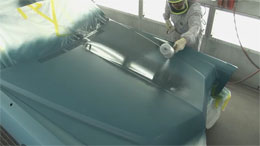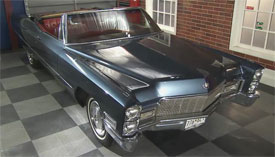Caddy Paint
Restoring an old car is often more work than you bargain for, so here’s our Pat Goss with some colorful tips.
PAT GOSS: When we last saw our Cadillac convertible, it was in primer and looking like it was ready for paint, but that isn't entirely the case. With us again is Pete from Classic Car Shop. Pete, welcome back to the show. What have you done since we last saw the car?
 PETE: Well the last time it was in, it was in the first coat of primer. Basically, from that stage, there's still a lot more preparation that needs to be done to complete the car. And that's where a lot of the car owners they shortchange when they're doing the job, on the side, in their house, as opposed to taking it to a professional. The car then needs to be sanded by hand, with a block. Blocks are like this, they come in variable lengths and sizes and shapes depending on the contours of the body of the car. We then, after we sand the entire car, we prime the car again with a filler-primer.
PETE: Well the last time it was in, it was in the first coat of primer. Basically, from that stage, there's still a lot more preparation that needs to be done to complete the car. And that's where a lot of the car owners they shortchange when they're doing the job, on the side, in their house, as opposed to taking it to a professional. The car then needs to be sanded by hand, with a block. Blocks are like this, they come in variable lengths and sizes and shapes depending on the contours of the body of the car. We then, after we sand the entire car, we prime the car again with a filler-primer.
PAT GOSS: Alright now, one of the things, like little pockmarks and so on, do-it-yourselfers usually shortchange themselves. How does that work?
PETE: Well a lot of times what they'll do is just take a little sander and they'll sand a little bulls eye out and they think it looks real smooth, and they spray a little primer on it, and then when the car gets painted, that imperfection is still standing out there looking at them.
PAT GOSS: It looks like a bulls eye then. Ok, now, at that point, it's ready for paint, what happens?
 PETE: Basically, then the car gets sanded again, by hand or by machine, and then the car goes into the spray booth and gets sprayed with, on this car we used a waterborne base coat clear coat system.
PETE: Basically, then the car gets sanded again, by hand or by machine, and then the car goes into the spray booth and gets sprayed with, on this car we used a waterborne base coat clear coat system.
PAT GOSS: Alright now a lot of people may not be familiar, waterborne is simply that the paint is water-based.
PETE: Correct.
PAT GOSS: Yeah. Ok. Now you changed color.
PETE: Yes, we did a complete color change on this car, but we did what we call the “used car special.” Because the owner of the vehicle was on a budget, we did a real nice exterior finish on it, but didn't have enough money to remove all of the panels on the car, all of the upholstery, the dashboard, to sand and prep the entire car in the door jams.
PAT GOSS: So, a true color change is very expensive.
PETE: It's very expensive. It's because it's so costly, time consuming job. So we just basically scuffed and shot the entire jams and painted the car with the car in a complete fashion.
 PAT GOSS: And unless you're doing a show car, that's perfectly acceptable.
PAT GOSS: And unless you're doing a show car, that's perfectly acceptable.
PETE: Yes, especially on this vehicle. The car is a driver, and the guy's not going to show it or anything like that.
PAT GOSS: Ok. Pete, thank you very much. And we'll keep you posted as we progress with our Cadillac restoration. And if you have a question or a comment, drop me a line, right here, at MotorWeek.





